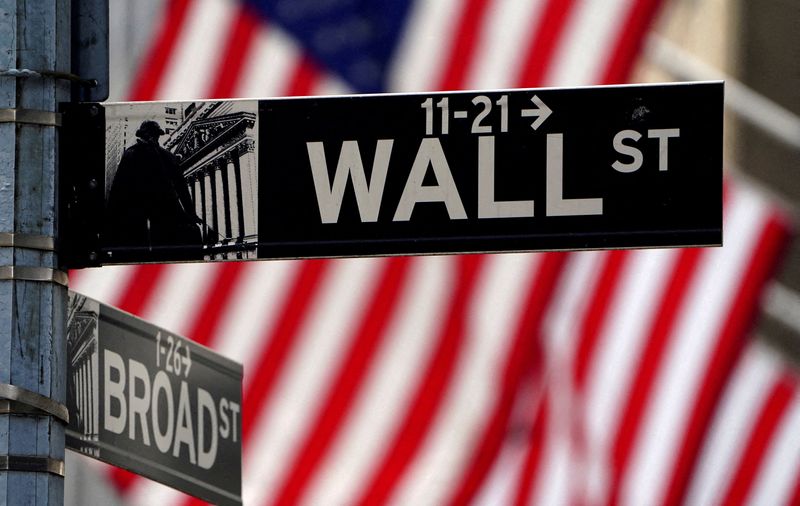By Sinéad Carew and Shubham Batra
(Reuters) -Wall Street's three major indexes gained more than 1% on Monday as investors looked for bargains after the previous week's sell-off while they also waited for inflation reports in coming days and the Federal Reserve's next policy decision next week.
Investors had fled from equities last week when Friday's weaker-than-expected August jobs data followed weak manufacturing data on Tuesday, driving the Nasdaq Composite's biggest weekly loss since January 2022, and the S&P 500's biggest weekly decline since March 2023.
Along with jitters about the U.S. economy's health investors have been contending with uncertainty about the Fed's interest rate decision due Sept. 18. But they arrived at their desks in what looked like more bullish moods on Monday.
"Investors had a little time over the weekend to think about things. Clearly there was an overreaction to economic data last week. It raised overblown fears of a potential recession," said Kristina Hooper, chief global market strategist at Invesco. "A pause gives you the opportunity to be more rational."
The Dow Jones Industrial Average rose 484.18 points, or 1.20%, to 40,829.59, the S&P 500 gained 62.63 points, or 1.16%, to 5,471.05 and the Nasdaq Composite gained 193.77 points, or 1.16%, to 16,884.60.
This week's key events include the consumer price index (CPI) report, due Wednesday morning after Tuesday night's first debate between U.S. presidential candidates Democrat Kamala Harris and Republican Donald Trump ahead of the Nov. 5 election.
But in the meantime Phil Blancato, chief market strategist at Osaic Wealth, New York said investors are taking another look at "high quality stocks that are cheaper."
In particular Blancato pointed to shares of market heavyweight and artificial intelligence chipmaker favorite Nvidia (NASDAQ:NVDA), which closed up 3.5% on Monday after falling 15.3% last week.
However, since trading is usually more muted before big economic news, Blancato was concerned to see a rally before Wednesday's CPI inflation report, which is expected to help inform whether the Fed cuts rates by 25 or 50 basis points.
"The market's expecting a very soft print and locking in a Fed cut. What happens if we don't get that?" said Blancato who expects volatility after whatever decision the Fed makes.
Some investors will be disappointed if the Fed only cuts rates by 25 basis points but if the cut is double that, they will be worried that the Fed has big concerns about the economy.
"It's a lose-lose situation," the strategist said.
Wednesday's report is expected to show a moderation in headline inflation in August to 2.6% on a yearly basis, while on a monthly basis it is expected to remain unchanged at 0.2%. The CPI report will be followed by producer prices data on Thursday.
Shares in Apple Inc (NASDAQ:AAPL) had a lackluster day on Monday, closing up just 0.04% after earlier falling almost 2% as it unveiled its artificial intelligence-boosted iPhone 16.
The eleven major S&P 500 industry sectors closed higher, with consumer discretionary leading gains, up 1.63% followed closely by industrials, which added 1.56%. The smallest gainer was communications services, which added 0.04%.
Apple's long-awaited phone launch came hours after Chinese rival Huawei began racking up orders for its tri-fold Mate XT phone.
Boeing (NYSE:BA) shares advanced 3.4% after the planemaker and its biggest union reached a tentative deal covering more than 32,000 workers, averting a possible strike.
Shares in Palantir (NYSE:PLTR) rose 14% and Dell Technologies (NYSE:DELL) added 3.8% on the news issued late Friday they will join the S&P 500 index on Sept. 23.
In the benchmark index, these stocks will replace American Airlines (NASDAQ:AAL) Group, which added 3.9%, and Etsy (NASDAQ:ETSY) , which fell 1.6% and Bio-Rad Laboratories (N:BIO), which closed down 2% on the day.
On U.S. exchanges 10.75 billion shares change hands compared with the 10.72 billion moving average for the last 20 sessions.

Advancing issues outnumbered decliners by a 2.16-to-1 ratio on the NYSE where there were 258 new highs and 111 new lows.
On the Nasdaq, 2,548 stocks rose and 1,616 fell as advancing issues outnumbered decliners by a 1.58-to-1 ratio. The S&P 500 posted 27 new 52-week highs and 4 new lows while the Nasdaq Composite recorded 45 new highs and 177 new lows.